- - A list creation
- - A list being processed
- - A function with parameters and sequencing, selection, and iteration
- - Call to function
- List creation
- List processing
- Function with parameters
- Call to function
- CPT Requirements
- Accomplishments
- 🎯 My Top 5 Accomplishments
- Write up
- ✨ Project Feature blog write up ✨
- 🚀 Goals for furture 🚀
- Night at the Museum feedback


# First MC vs. Last MC
- First MC = 35 points
- Second MC = 52 points
- 17 point increase!

Compared to my original score, I increased significatnly in all categories. However in both MCs, Big Idea 3 was where I struggled the most.
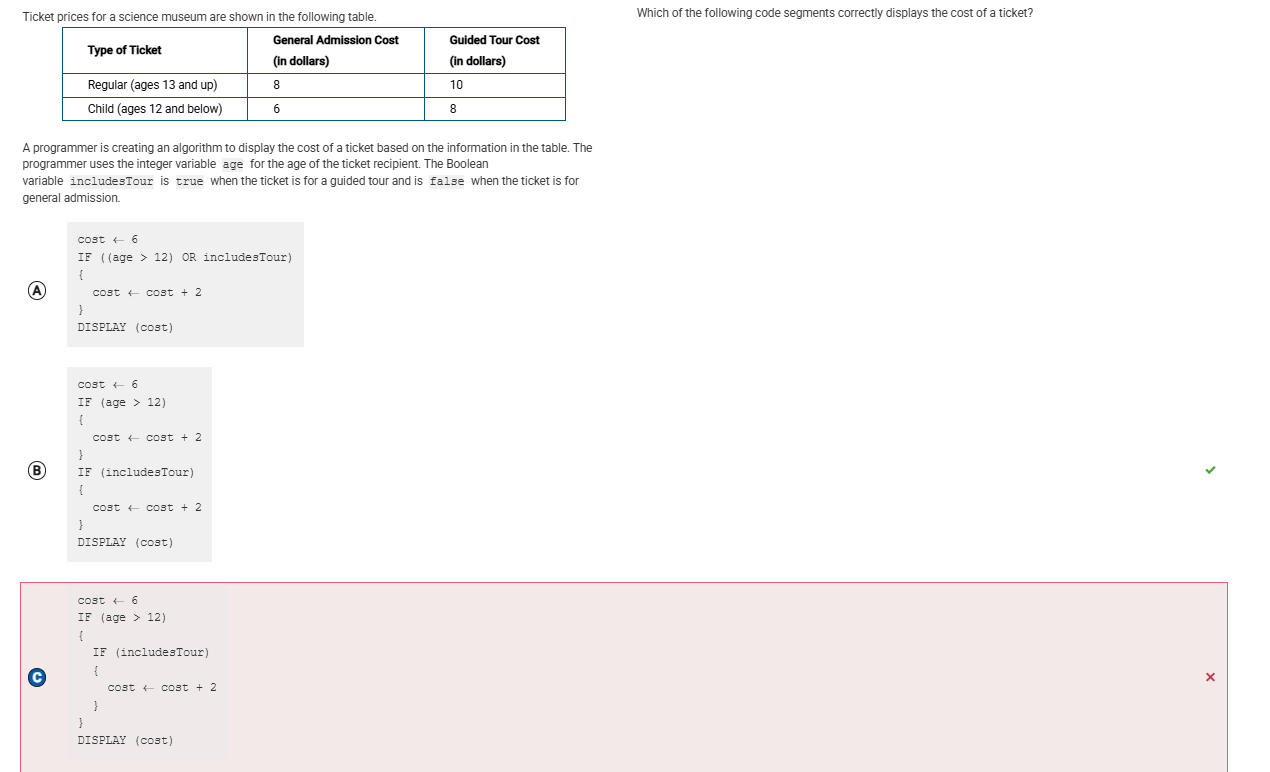
This code segment initially sets cost to 6 (the cheapest possible ticket price), then increases cost by 2 for people whose age is greater than 12. Regardless of the person’s age, cost is increased by 2 for people going on a guided tour.

Since x is true, the body of the IF statement is executed. Since x OR y evaluates to true, true is displayed.
# Key Areas for Improvement
# 📌 1. Identifying and Correcting Errors (1.4) - 43%
- Focus on debugging techniques, error detection, and logical errors in code.
- Aligns with: Big Idea 1: Creative Development
# 📌 2. Conditionals (3.6) - 0%
- Study how if-statements and Boolean logic control program flow.
- Aligns with: Big Idea 3: Algorithms and Programming
# 📌 3. Nested Conditionals (3.7) - 50%
- Practice handling multiple layers of conditional logic.
- Aligns with: Big Idea 3: Algorithms and Programming
# 📌 4. Iteration (3.8) - 60%
- Improve understanding of loops (for/while) and their applications.
- Aligns with: Big Idea 3: Algorithms and Programming
# 📌 5. Developing Algorithms (3.9) - 75%
- Work on structuring and optimizing algorithms.
- Aligns with: Big Idea 3: Algorithms and Programming
# 📌 6. Random Values (3.15) - 50%
- Learn how randomness is implemented in programming.
- Aligns with: Big Idea 3: Algorithms and Programming
# 📌 7. Algorithmic Efficiency (3.17) - 0%
- Study efficiency (Big-O notation concepts), optimizing code, and computational complexity.
- Aligns with: Big Idea 3: Algorithms and Programming
# 📌 8. Legal and Ethical Concerns (5.5) - 67%
- Review ethical computing, intellectual property, and privacy concerns.
- Aligns with: Big Idea 5: Impact of Computing
# Strengths
- Binary Numbers (2.1) - 100%: Strong understanding of binary representations.
- Data Compression (2.2) - 100%: Mastery in reducing data size and compression algorithms.
- Boolean Expressions (3.5) - 100%: Confident with logical expressions and truth tables.
- Strings (3.4) - 100%: Comfortable with string manipulation and operations.
- Developing Procedures (3.13) - 100%: Strong ability to write and structure procedures.
- The Internet (4.1) - 100%: Clear understanding of internet protocols and how data is transmitted.
- Fault Tolerance (4.2) - 100%: Strong knowledge of system reliability and redundancy.
- Safe Computing (5.6) - 100%: Good awareness of cybersecurity and best practices.
# Focus Areas (Most Important Units)
- Unit 3: Algorithms and Programming (Major Weaknesses: Conditionals, Iteration, Algorithmic Efficiency)
- Unit 1: Creative Development (Needs improvement in debugging and error correction)
- Unit 5: Impact of Computing (Legal and Ethical Concerns need review)
# Realistic Study Strategy
- Review Weak Areas: Focus on practice problems for debugging, conditionals, iteration, and algorithm efficiency.
- AP Classroom & College Board Resources: Use official practice questions and videos.
- Code Practice: Implement and test concepts in Python to reinforce understanding.
- Exam Strategies: Work on timing and eliminating incorrect answer choices efficiently.
Overall, I think I improved significantly from the MC we took at the begnning of the tri. I developed my skills and understanding on Unit 4 a lot. However, this is still a long way to go especially in Unit 3, which is where most of my mistakes were.
- A list creation
- A list being processed
- A function with parameters and sequencing, selection, and iteration
- Call to function
List creation

Southafrica was what defined the lists and the according parameters. The data for southafricas restaurants are stored in this list.
List processing

This code uses listing and a loop to iterate and display the data through the print command.
Function with parameters
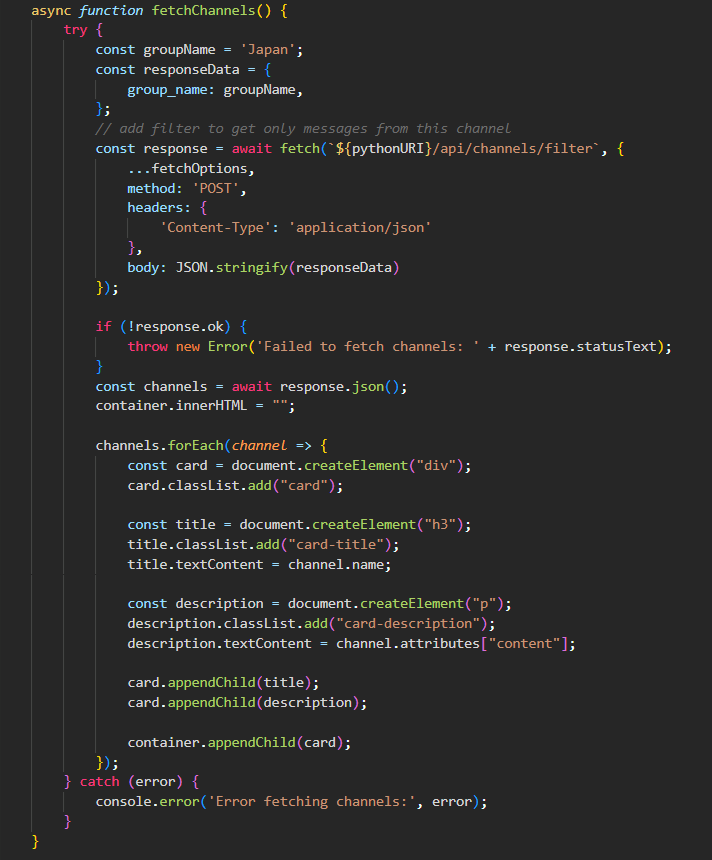
the Fetch command is defining the procedure and returns an API endpoint. Its parameters include groupName which filters our the data. Sequencing is shown in the fetch of API data and the dynamic display. Selection is in the error feature. Iteration is in the for loop updating the frontend UI.
Call to function
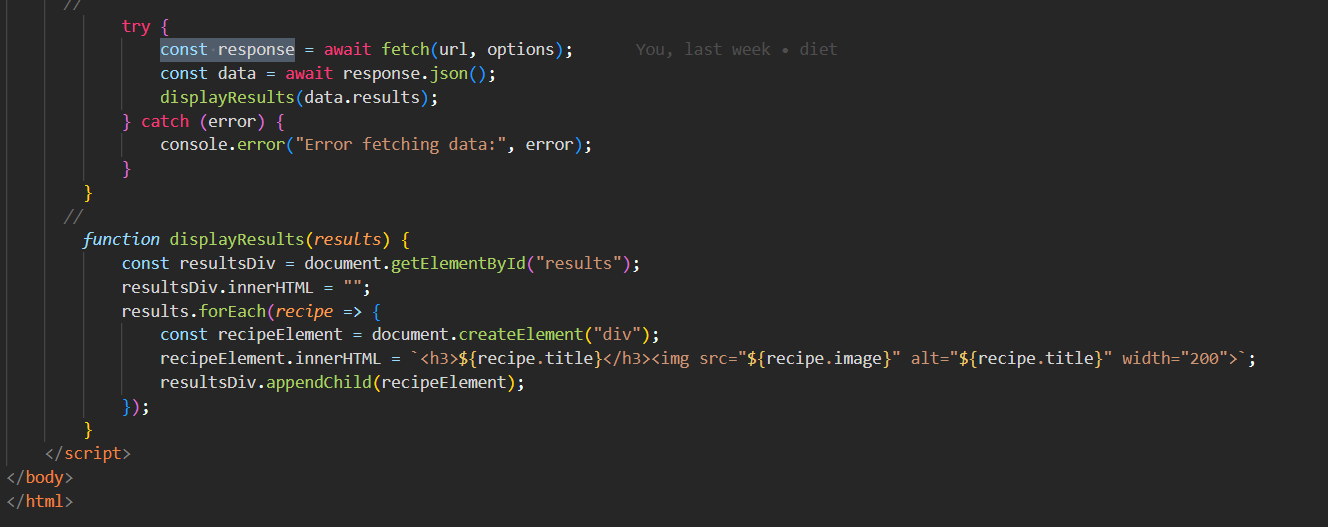
The fetch command ensures that all the data is up to date and is displayed properly.
CPT Requirements
Big Idea 1
- Induvidual: I kept the team organized by created several issues to outline our plans and takeaways. For night at the museum, I created a detailed out;ine of everyones induvidual role and after I crated an issue for our key focuses of strengths and weaknesses and what action we need to take with this feedback. Team: As a team we stayed highly coordinated with our figma board and kanban board. We knew our key focuses as well on the agile meathod and CRUD.
Big Idea 4
- Induvidual: I spent a lot of time making a poster that defines and abstracts the big idea. I also shared this poster with others as well outside of my team and was able to teach what I put together. This also helped my understanding of the concepts immensly.
- Group: I worked with another member in my group on this pster which helped on my collaboration. As a team we were also able to deploy our website securely.
Big Idea 3
- Induvidual: I attacked algorithms and programming because they are used in coding to simplify complex tasks. I used APIs to create a personalized diet feature for users. This provides predefined functions that developers can use without knowing their internal workings. This API also steamlines code as it was reusable and saved resources.
- Group: We collectively streamlined data to make it appear simple and user friendly on the frontend.
Accomplishments
🎯 My Top 5 Accomplishments
🥇 Achievement 1: Organization
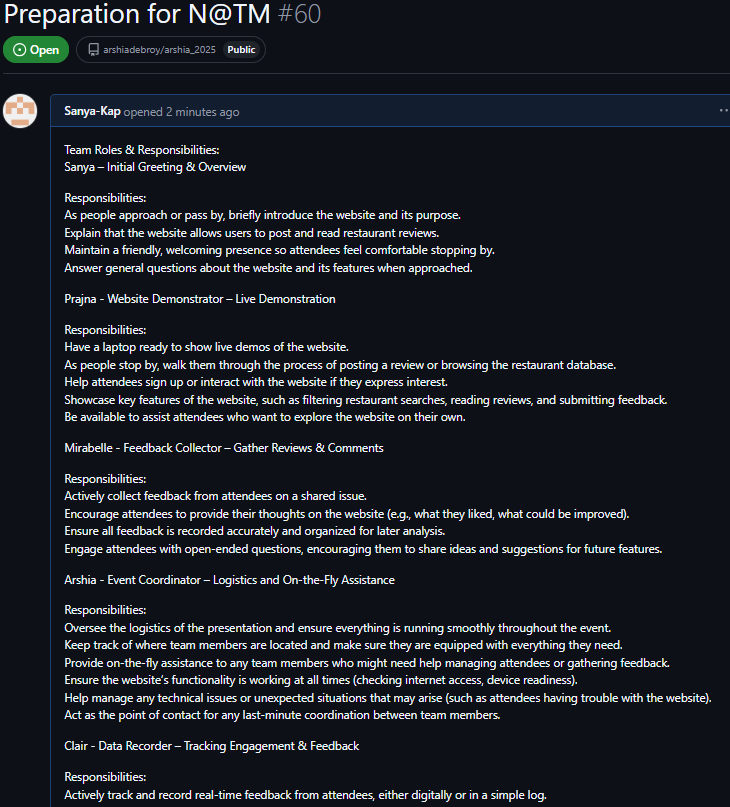
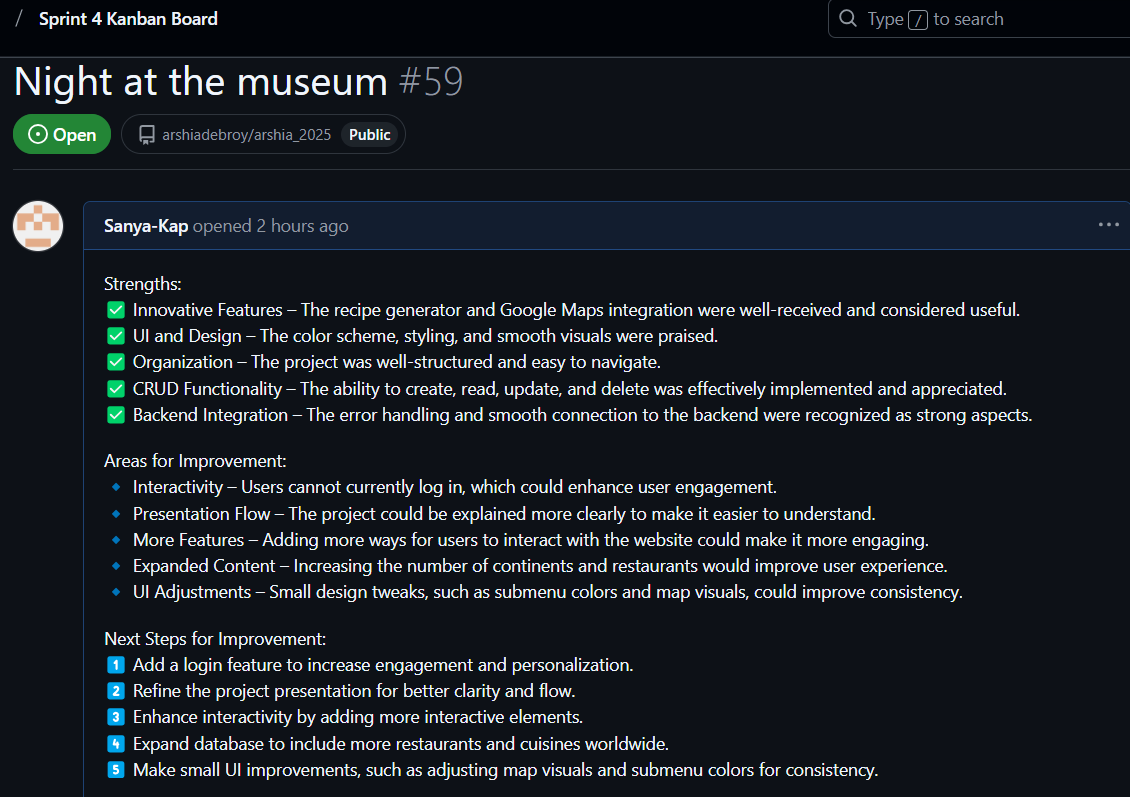
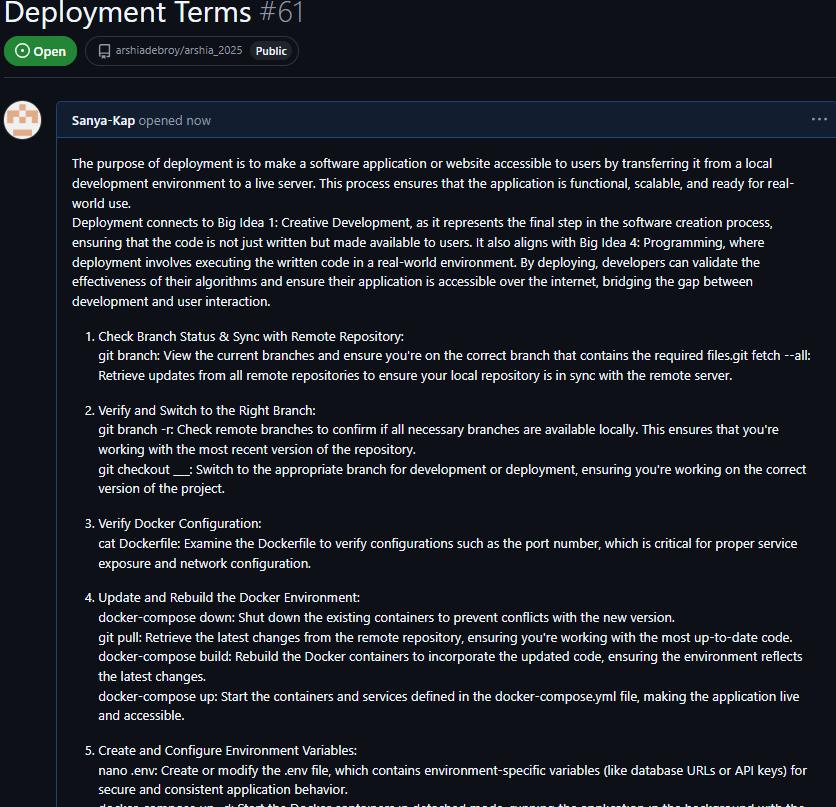
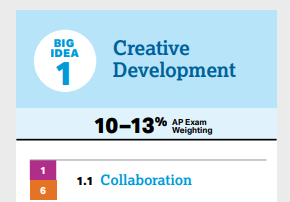
—
🥈 Achievement 2: Static data
This Python script defines a Flask RESTful API for retrieving restaurant information in South Africa.
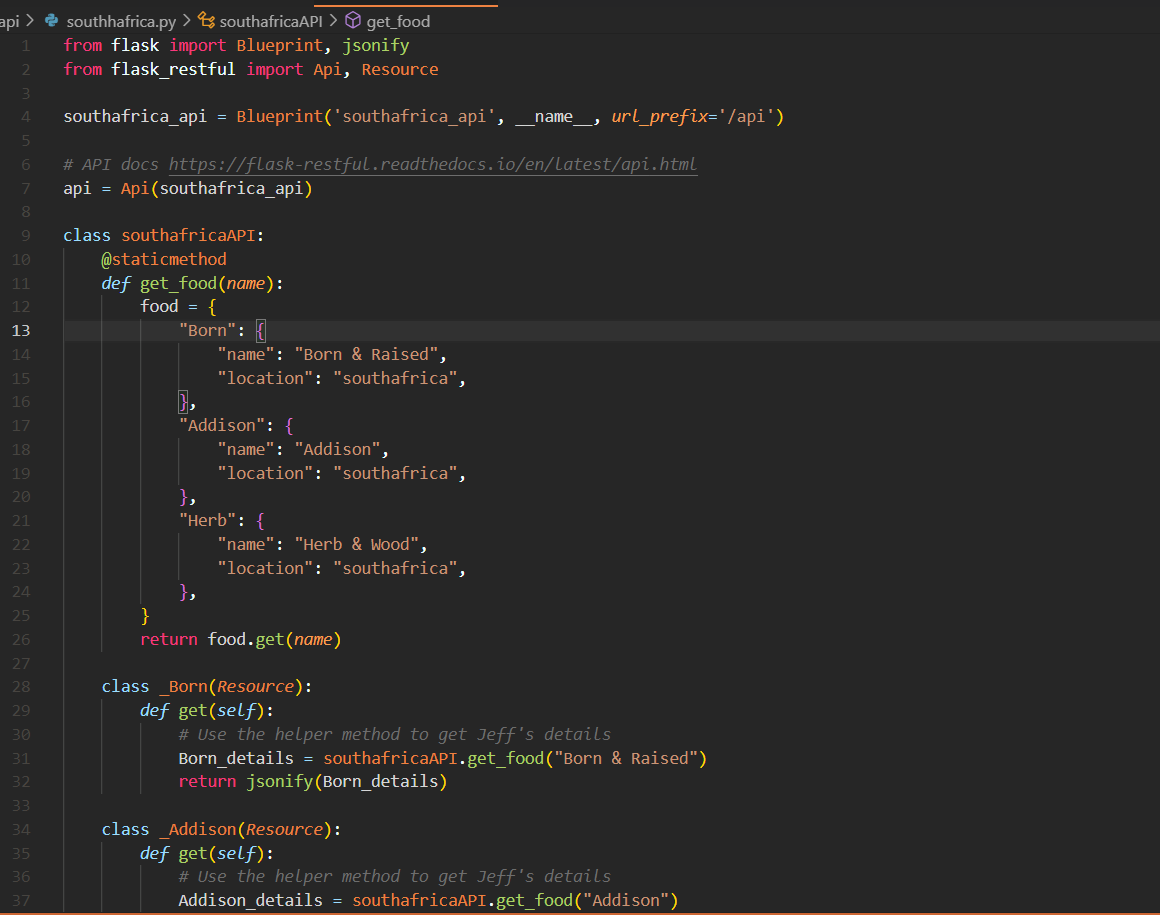
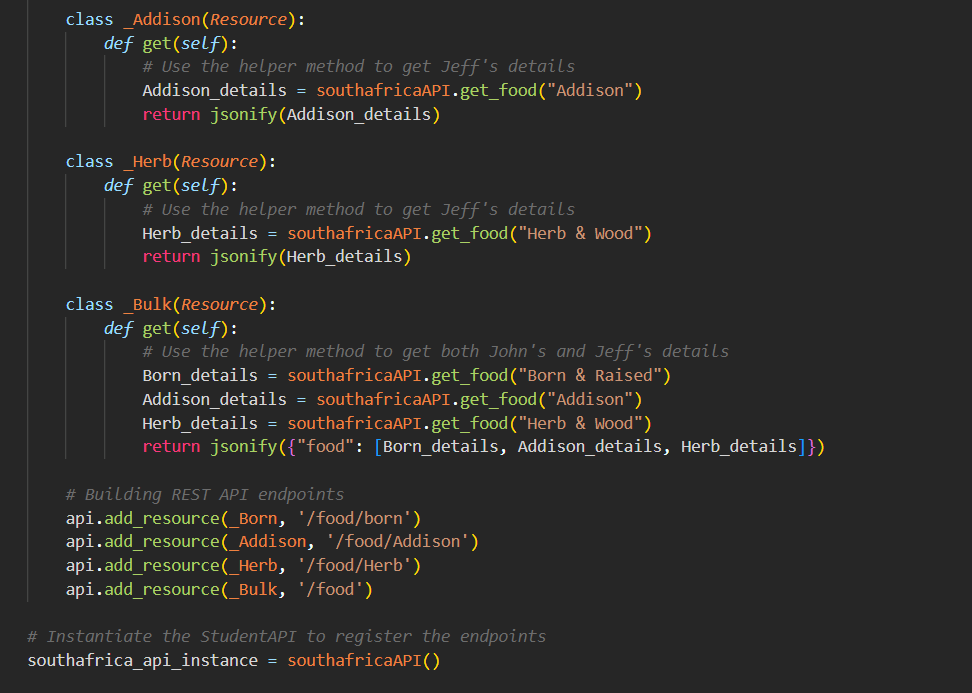
Writing code that works with static data, like storing and retrieving information from a dictionary or table, aligns with Big Idea 2: Data in AP CSP. Specifically, it covers:
Data Abstraction: Using structured formats (e.g., dictionaries, lists, tables) to organize and manage data efficiently. Storage & Representation: Storing data in a way that allows for easy access and retrieval, such as using dictionaries for key-value pairs or Markdown tables for structured display. —
I learned that Flask-RESTful is API structured using a Blueprint, allowing modular organization and enabling multiple endpoints under the /api prefix. The southafricaAPI class defines a static method, get_food(name), which retrieves restaurant data from a dictionary-based data structure. Each restaurant is mapped to a RESTful resource, inheriting from Resource, and implements a get() method to return JSON-encoded responses. The API follows a declarative routing pattern, using api.add_resource() to associate endpoints like /food/born with their corresponding data. Additionally, a bulk endpoint consolidates all restaurant information into a single JSON response, improving data retrieval efficiency. This modular design adheres to abstraction and encapsulation principles, promoting scalability and maintainability.
🥉 Achievement 3: San Diego Frontend
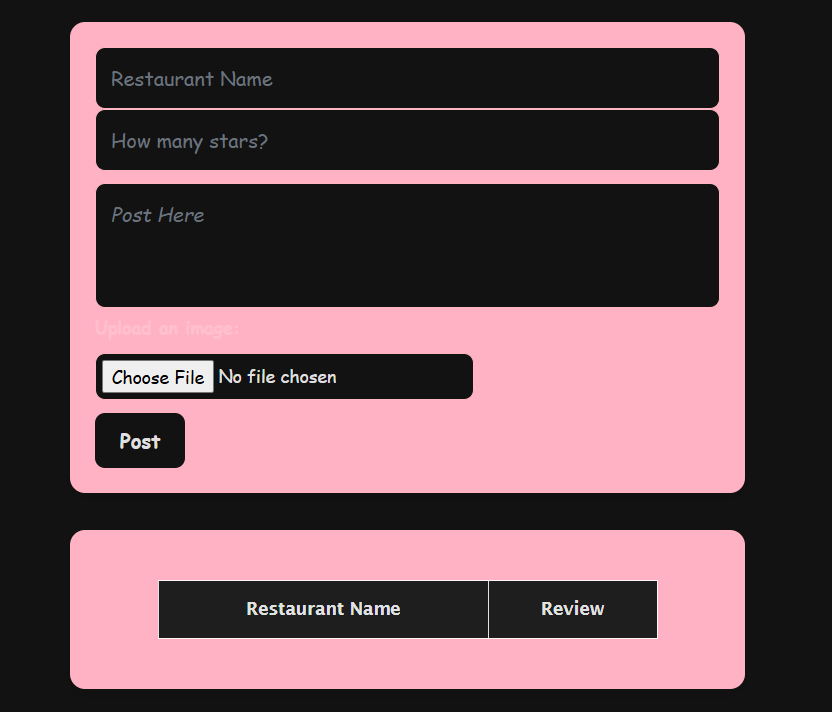
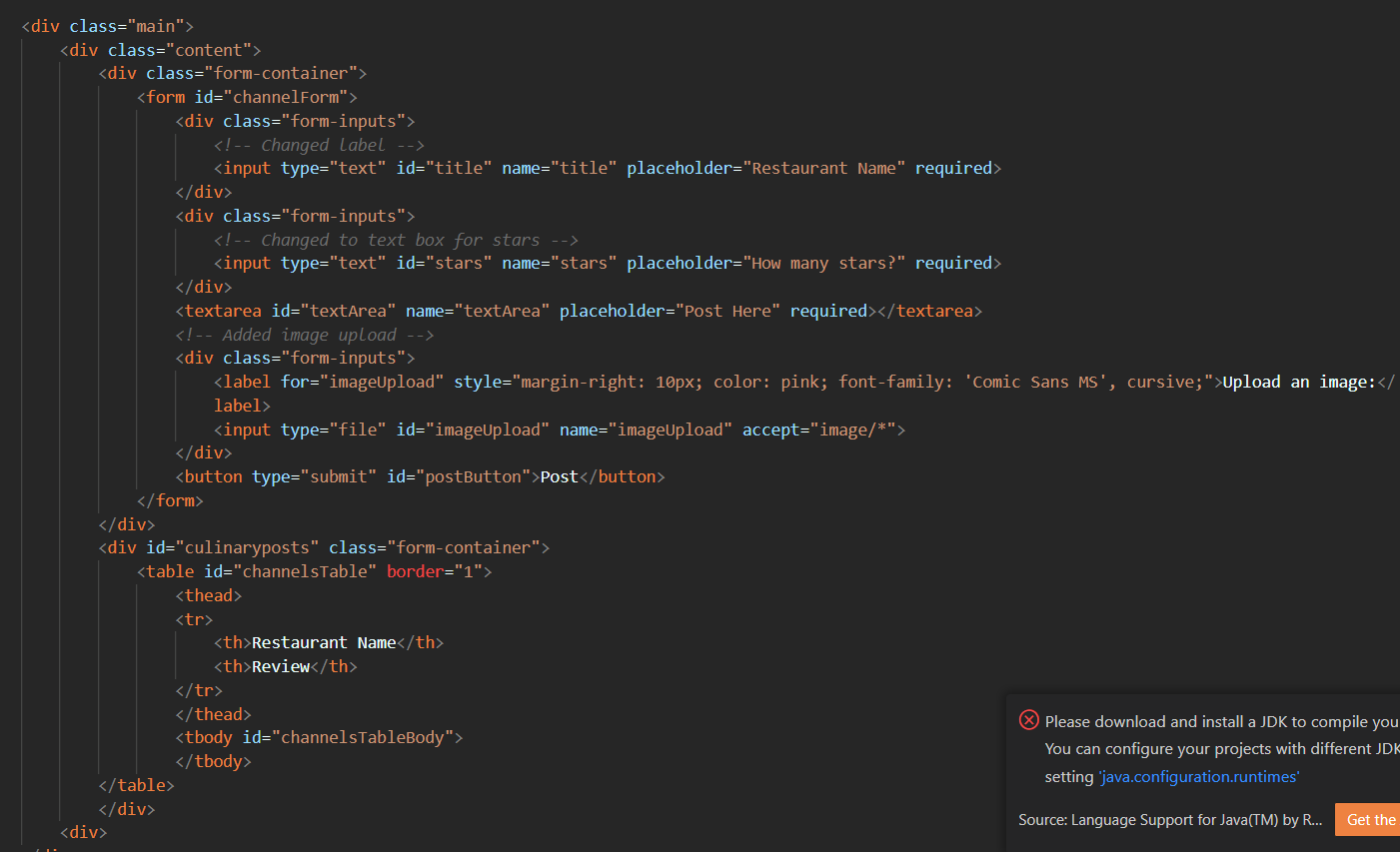
This table is unique to san diego because it directs the posts to this table, instead of floating around beneath the posting feature.
🎖️ Achievement 4: Diet feature
📌 



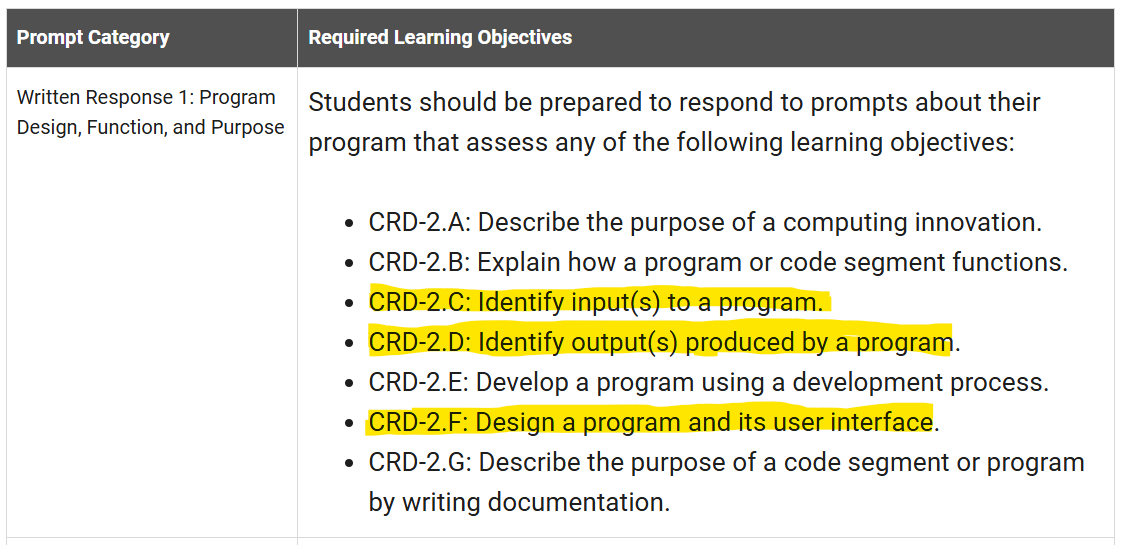
🎖️ Achievement 5: Big Idea 4 Poster
📌 Big Idea 4 Poster.
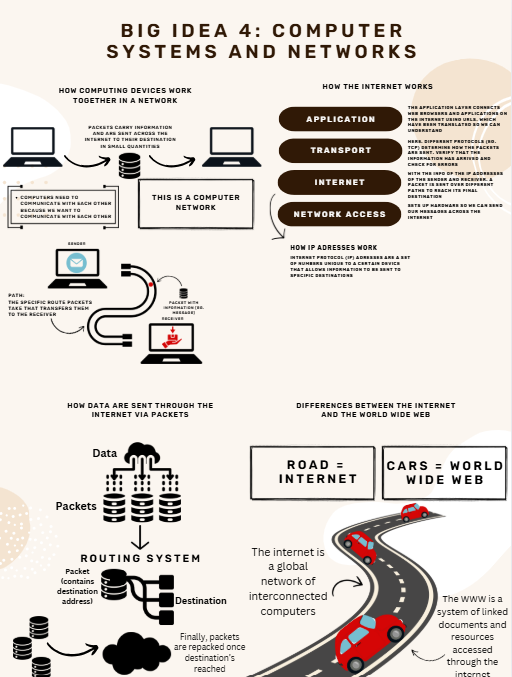
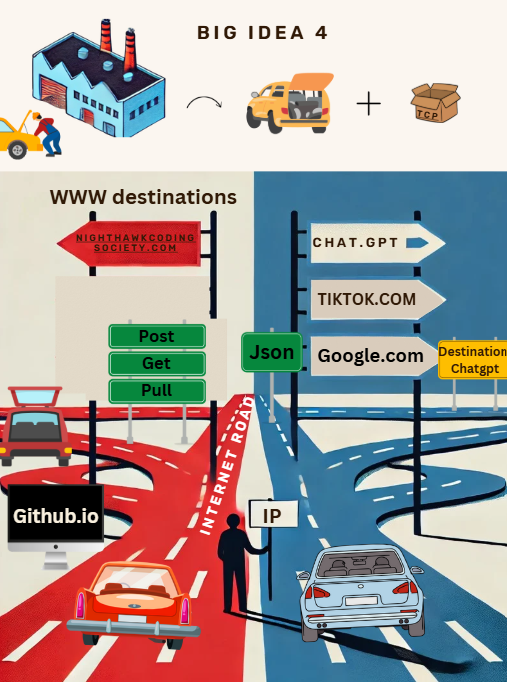
["1.A", "Investigate the situation, context, or task."],
["1.B", "Determine and design an appropriate method or approach to achieve the purpose."],
["1.C", "Explain how collaboration affects the development of a solution."],
["1.D", "Evaluate solution options."],
["5.A", "Explain how computing systems work."],
["5.B", "Explain how knowledge can be generated from data."],
["6.A", "Collaborate in the development of solutions."]
I designed a detailed and visually appealing poster for Big Idea 4. The poster highlighted key definitions and real-world applications that aligns with what we built in class. This helped my understanding as putting the diagram together helped me piece together the different parts of the internet protocal. I learned how data is transfered through smaller packets and how computers communicate along the network. Having a visual summary helped my classmates engage with the material beyond classroom work and lectures.Some students learn better visually, and my poster provided an alternative method to absorb the information.
Write up
✨ Project Feature blog write up ✨
This trimester has taught me a lot about Big Idea 4 through my poster and hands on experience with deployment. I did not have a strong grasp on the main ideas because of the different teaching style I had in trimester one. So jumping into creating features and using APIs acceslerated my knowledge and ability to code by a lot. I did stuggle at first, but I learned so much being exposed to deployment, APIs, and frontend vs backend.
🚀 Goals for furture 🚀
There is still a lot for me to improve on. For Next Trimester, I have clear goals of improving my fundamental understanding of code segments and fixing errors. I want to go deeper into my learning on API development. In the future, I want to go into biomedical engineering so this class helped me bridge my introduction to engineering.
Night at the Museum feedback

Based on reviews, to make it more user friendly and appealing, I created and styled a new feature. This also aligns with the feedback we got from night at the museum to make it more personalized.


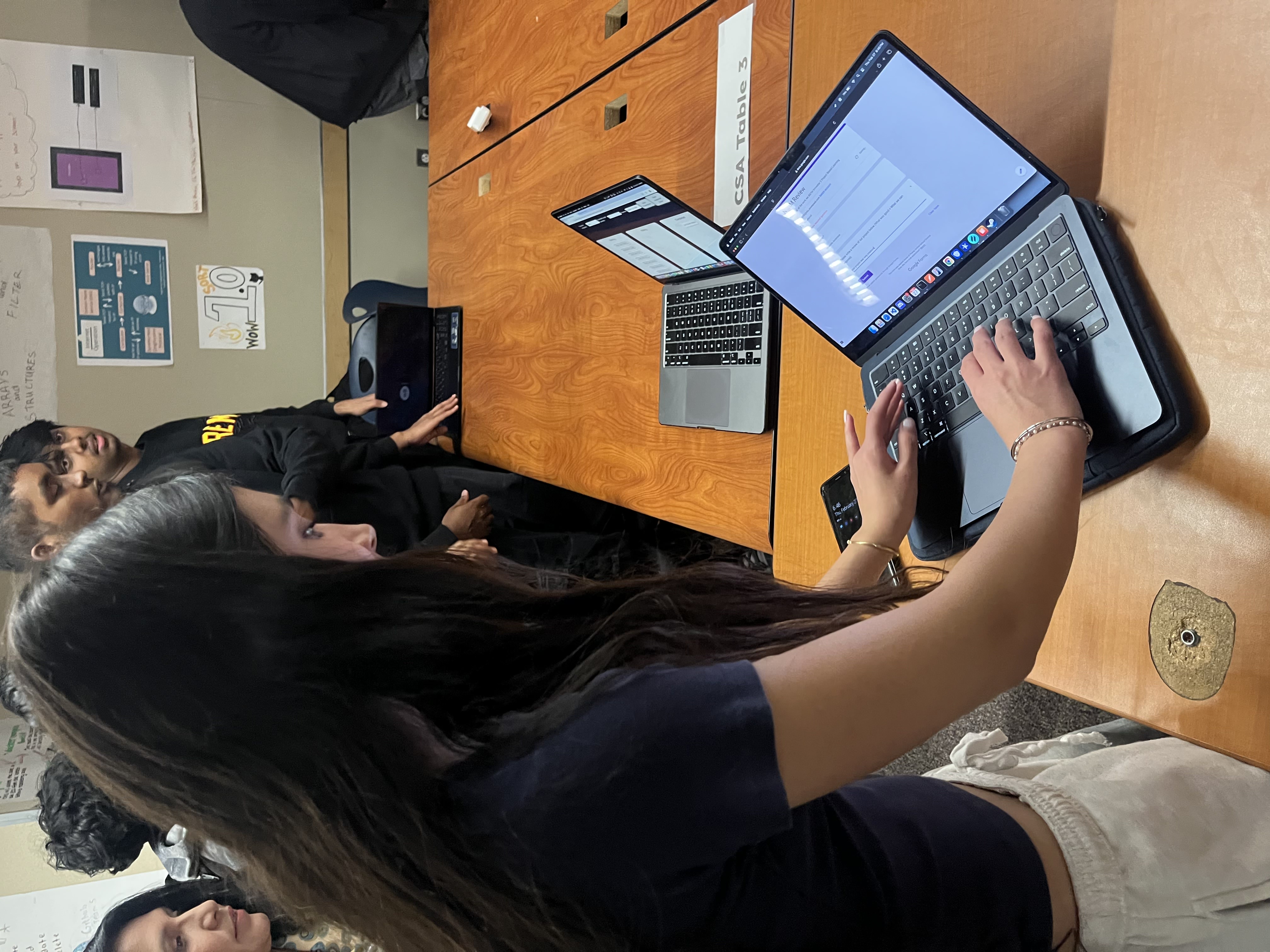
While at Night at The Museum, one CSA project I found especially intreresting was a stocks website, which actively updated stock values. I left a review and some suggestions for improvement.
Additionally, the poster that I designed and collaborated on helped me advance some of my understandersings on Big Idea 1,5 and 6.

Requirement Description
1.A Investigate the situation, context, or task.
1.B Determine and design an appropriate method or approach to achieve the purpose.
1.C Explain how collaboration affects the development of a solution.
1.D Evaluate solution options.
5.A Explain how computing systems work.
5.B Explain how knowledge can be generated from data.
6.A Collaborate in the development of solutions.
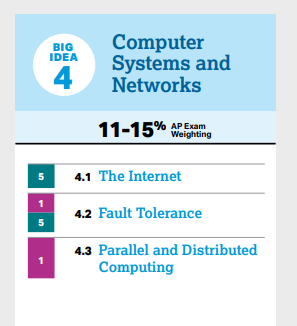
Induvidual Features: 5/5
CPT Requirements and N@TM: 2/2
Write up/Self Reflection: 1/1
MCQ: 1/1
Reflection/Self Assessment: 0.4/1
OVERALL: 9.4/10
I do not think I earned a 10/10 because I am still solidifying my knowledge on deplyment. However, I was extremely focused on enhancing my skills and understanding of APIs and collaboration on working towards the CPT requirements accelerated my knowledge which is why I think I earned at least a 9/10. I went beyond to help others with my Sprint 4 poster, organizing our events for N@TM, created a detailed overview of my strengths and weaknesses from the MC and my personal features, created next steps, created an honest self assessment based on the CPT requirements, and took interest in others projects during night at the museum and creating a review of what my group needs to work on. Therefore, I think I earned a 9.5/10 overall.
